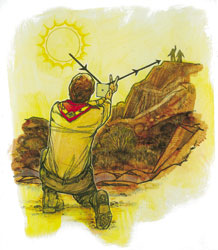![]() March-April 2001
March-April 2001
By Malcolm Murray
Illustration by Joel Snyder
 For emergency signaling, sight through a V on your outstretched hand, then aim sunlight at the target. |
On August 4, 1991, four people found themselves floating in life vests after their plane ditched off the Bahamas. During the hours that followed, several boats and aircraft passed nearby, but their crews did not notice the small figures floating in the ocean. Then, after two nights in the water, the crash survivors were finally rescued when they used shiny credit cards to reflect sunlight at a plane.
The case dramatizes the fact that individual survivors, whether on land or sea, are difficult to spot from the air unless they have something to aid searchers in finding them. A basic way to alert potential rescuers is by flashing a light signal powerful enough to get their attention.
A signal mirror is the simplest and most reliable device for this purpose. The technique of reflecting sunlight doesn't present the problem of low battery power or chemical exhaustion that can affect other emergency light sources. And any handheld mirror or flat, shiny surface can be used to accomplish the task.
"The signal mirror is the most basic and best all-around signaling device," says survival authority Douglas S. Ritter. "Compact and simple to operate, it has been successfully used for many rescues."
On his "Doug Ritter's Equipped to Survive" Web site (http://www.equipped.org), Ritter evaluates outdoor gear and survival equipment and discusses survival and search and rescue topics. "While any shiny object can be used for signaling," he notes, "a [specially designed] signal mirror is generally brighter, and the best [ones] are much easier to aim."
Any mirror or other shiny surface can be roughly aimed by reflecting sunlight through a V on one's outstretched hand. Sight through a hole in the mirror, or over the mirror, and through the V at a distant target. (The highly polished 3 1/2-inch-by-2 3/4-inch metal mirror in the BSA Supply Division catalog, No. 01210, has a tiny hole in its center for use as a signaling device.)
However, simple mirrors of this type are neither easy to use nor highly efficient for signaling. Considerable practice is necessary to effectively use one as a reflective signaling device.
A note of caution: While practicing or using a mirror for signaling purposes, it is important to never reflect sunlight at a person, motorist, or cyclist at short range, or at an airplane as it lands or taxis. This can cause momentary blindness, resulting in an accident.
More effective and user-friendly are the newer, specially designed plastic signal mirrors. They have a built-in aimer for easier, more precise focusing on a potential rescuer.
These modern plastic mirrors can be used with one hand, are designed to float, weigh less than metal or glass mirrors, and are less easily damaged. They typically have a range of 15 to 20 miles and cost from $5 to $20.
To test a device of this type, reflect the sun at a shaded vertical surface at least 50 feet away. The reflected light spot should be round and uniformly bright, not irregular or diffused. Also check that the aimer produces a white spot when sighting on a cloud or other distant target.
Other types of signal devices are found in modern emergency kits. Chemical lights, also known as "light sticks," can last up to 12 hours. They attract more attention when swung on a lanyard, but even then, they normally are not visible beyond a mile.
Battery-powered strobe lights can work at attracting attention even while a survivor is unconscious. They generate powerful light up close and at night.
However, both of these devices will eventually "run out." Chemical lights eventually lose their intensity while battery-powered lights are only as good as the cells that power them.
Be prepared with a good signal mirror. The life you save may be your own.
Malcolm Murray is president of Rescue Reflectors, Inc., Baytown, Tex., a manufacturer of plastic mirrors for rescue signaling and tank inspection.
Copyright © 2001 by the Boy Scouts of America. All rights thereunder reserved; anything appearing in Scouting magazine or on its Web site may not be reprinted either wholly or in part without written permission. Because of freedom given authors, opinions may not reflect official concurrence.
| The Boy Scouts of America | http://www.scouting.org |